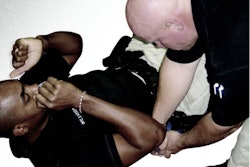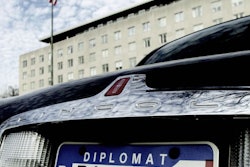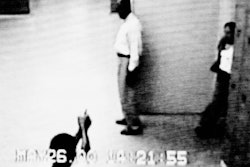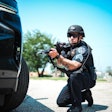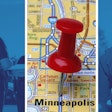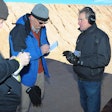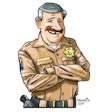Official reports say that just before 4 in the morning on Feb. 6, officers of the Los Angeles Police Department saw a maroon Toyota Camry zip through a red light. Officer Steve Garcia and his partner, who has not been named publicly, gave chase. About three minutes later, the Camry ran up on the sidewalk and stopped. The officers parked behind the car, the Camry's passenger door flew open, and a 14-year-old boy ran down the street.
Garcia got out of the patrol car. Then the Camry's driver, 13-year-old Devin Brown police say, made a fateful move. He either panicked and threw the car in reverse, rammed the patrol car to make a run for it, or tried to intentionally injure the officers. We may never know. But for one of these reasons, or maybe for another that's not readily apparent, he reportedly reversed that Camry into the patrol car. Garcia opened fire, killing the boy. It was later discovered that the Camry had been reported stolen.
At presstime many things had still not been publicly released regarding the Devin Brown incident. LAPD detectives, the Los Angeles County District Attorney's office, and the FBI were all investigating the shooting. So it's not known where Garcia was standing when he discharged 10 rounds into the Camry. And it's not known if his use of deadly force was justified.
But one thing that is known is that the Devin Brown shooting ignited a firestorm of controversy. Brown was African-American, and the shooting reinforced the impression among L.A.'s black community that the city's police are "trigger happy" when it comes to black suspects.
Nothing could be more politically charged in Los Angeles than the killing of an "unarmed" black teenager by the LAPD. This is especially true when the Devin Brown shooting is seen against the backdrop of one of the most vicious mayoral races in Los Angeles history. At the time of the shooting and for weeks following as the black community reacted, Mayor James K. Hahn was in a fight for his political life against challenger Antonio Villaraigosa. Some analysts say it looks like Hahn pressured LAPD Chief William Bratton to do something politically correct to help his foundering bid for reelection.
That's not true, according to LAPD spokesman Lt. John Vernon. What really happened, he says, is that the political fallout from the Devin Brown shooting merely expedited a policy change that was already under consideration. "Actually, [the day of the Devin Brown incident] that policy change was sitting in an assistant chief's inbox, and she had planned to bring it to the chief's attention the next time they met."
By all accounts, Bratton was unhappy with the LAPD's penchant for shooting at moving vehicles long before the Devin Brown incident. In 2004, his officers had shot and killed a robbery suspect who was slowly backing his car toward them. That incident, which was captured on tape by local media, brought this issue to Bratton's attention, and he didn't like what he saw. He asked his staff to modify LAPD's use-of-force policy to clarify the department's stance on shooting at or from moving vehicles and bring it more in line with the standing policies of New York, Boston, Chicago, Houston, and other major cities.
The LAPD's use-of-force policy was officially modified 10 days after the Devin Brown incident to prohibit firing at or from cars. Basically, the policy orders officers to get out of the way of vehicles that are trying to run them down and not to fire on the vehicle unless the occupants are "immediately threatening the officer or another person with deadly force by other means than the vehicle." The policy goes on to leave a little bit of gray area for officers who have no other means of escape from a vehicular attack other than to shoot the driver.
Some LAPD officers and police union reps responded to the new policy with cries that it would endanger officers' lives. However, police trainers and use-of-force policy experts interviewed by POLICE say that chiefs who order their officers to stop shooting at vehicles may actually save the lives of some brave but misguided officers who are using poor tactical judgment.
It Keeps on Going
Tactically, shooting at a car that is trying to run you down is not a percentage play. "We've always taught that it's not a good tactic to be shooting at an oncoming car," says Dep. Mike Fass of the Harris County (Texas) Sheriff's Department, which last year revised its use-of-force policy to prohibit shooting at moving vehicles, except in extraordinary circumstances.
Fass applauded the change because it helped reinforce what he teaches at the Harris County Academy. "We've long been of the opinion that the time that you would spend executing a five-point draw, getting in a good position, getting your sight alignment, and maintaining trigger control would be more profitably spent laying a series of footprints at right angles to the oncoming car," he says.
Such sentiments are also voiced by other officers who have studied the tactical implications of attempting to stop a motor vehicle with a handgun.
A variety of things can happen when an officer attempts to shoot the driver of an oncoming car. Almost all of them are bad.
If you hit the driver and seriously wound or kill him, then the car will likely keep moving. It will just be out of control, which means that you have now created a greater hazard to yourself and the public.
Dr. Bill Lewinsky, director of the Force Science Research Center at Minnesota State University-Mankato, has studied the tactics of police shooting at cars. He says that shooting a driver in real life does not result in the car rolling to a gentle stop with the dead driver's head slumped on the blaring horn like it does in the movies.
"You can assume that the body might slump forward, but the pressure might increase to the gas pedal," Lewinsky says. "This means the car might even accelerate in the direction in which it was moving." So, Lewinsky points out, an officer standing in front of an oncoming car delivering .40-caliber rounds into the windshield is likely to be hit anyway.
A few other bad things that can happen when you shoot at cars include: hitting a passenger, hitting an innocent bystander, causing an out-of-control car to slam into a crowd of innocent bystanders, and, since handguns weren't made to shoot windshield glass, your round may ricochet and go God knows where. All of these bad outcomes could put you in a legal jackpot.
But let's say everything goes the way you wanted it to when you chose to fire on the driver of an oncoming car. Your shots find the mark. The driver is killed, and the car is stopped with no further injury to you or innocent bystanders. Even if your shooting was in policy with your agency, you are still likely in big trouble.
Remember, we're not talking about a case of a bad guy throwing shots at you from a car and you having to return fire. We're talking about shooting an otherwise "unarmed" driver who may or may not have been intending to run you down. Your local papers will hammer you with the fact that the driver was "unarmed." So will his or her attorney.
Worse, reflexes and physics being what they are, you will likely jump out of the way of the oncoming vehicle as you shoot and continue firing as it passes. Which means that when you fired the fatal shot, the threat to your life had ended.
And that's a real problem, says John Makholm, a veteran police officer and trainer who is also an attorney with Florida-based Peter M. Walsh & Associates. "We had a case in Gainesville, Fla.," Makholm says. "The officer was standing in front of the perpetrator's car, and the perp drove at him, and he shot the car coming toward him and going past him. If you are shooting at a car that's coming toward you, then I think it's a natural inclination to keep shooting as it passes you and after it passes you. The problem is, as it passes you, all things being equal, it's no longer a threat to you. After it has passed you and is going away from you, it's certainly no threat to you. You no longer have a reason to be shooting."
Academic research proves Makholm's point. Most cop vs. car shootings continue once the car has passed the cop. "Most of the time the bullets will go into the side of the car or even the back of the car," says Dr. Geoffrey Alpert, chair of the criminology and criminal justice department at the University of South Carolina. Consider for a moment how it will look in the papers and later in court that you shot an "unarmed" driver in the back.[PAGEBREAK]
When to Shoot
Does this mean that officers should never have the right to fire on a driver? Alpert, who has studied the phenomenon of cops shooting at cars for many years and who consults with law enforcement agencies to help them refine their pursuit and use-of-force policies, says that there are certainly times when a cop has to shoot a driver.
"You don't want a blanket policy that says you can't use your weapon," Alpert explains. "I've seen situations where officers have fallen down or they're backed in a corner and they can't retreat anymore. Then anything goes."
Such instances of an officer actually being run down by a vehicle and shooting to save his or her life are rare. But they do happen. There are, however, two more likely possibilities: Officers are run down and never have a chance to shoot; or the officers position themselves in the paths of oncoming vehicles, believing that their presence alone will force the drivers to stop.
Watch one of those Fox shows drawn from patrol car video systems like "World's Scariest Police Chases," and you'll see plenty of footage of officers hit by vehicles. And a quick search on Yahoo! for the words "police" and "run down" yields thousands of hits. No doubt some of these are about officers being tired or about officers running down suspects. But alarmingly, many of the first 50 links led to stories about American cops being run down by vehicles, including cars, SUVs, vans, trucks, and even ATVs. How many of these were intentional acts is hard to say.
The issue of intent is key to any discussion of cops being run down and choosing to fire on their "attackers."
But intent is hard to discern. It's not evident just from the fact that a car is moving toward the officer. The driver may just be trying to flee, not hurt a cop. This is especially true when the officer stands in front of the car in an attempt to impede the suspect's escape.
Body Block
Studies have shown that the majority of cop vs. car shooting incidents involved the officers using their bodies to block the car. This is a very poor tactic. It affords the officer no cover. It also places the officer in a position where, if the driver attempts to escape, the officer may interpret it as an attack and shoot.
"We did this thing in The Washington Post in the late '90s where I analyzed all of these shootings of vehicles for them," says Alpert. "I reviewed dozens of cases for them, and it was pretty horrifying to see that the majority of them were instances where the officers just stood there and then took shots at the fleeing person."
Standing in front of an oncoming vehicle trying to force the driver to halt just doesn't work, says Sgt. Craig Stapp, a firearms trainer with the Tempe (Ariz.) Police Department. "We're used to directing traffic, so we're use to standing in front of oncoming cars," he explains. "What we are confusing is the everyday guy who will pretty much obey our commands vs. the guy who wants to get away at all costs."
Not only is standing in front of a car to stop a fleeing suspect a bad tactic, it's also going make it easier for a suspect or his survivors to win a lawsuit against you if you do have to shoot.
"You don't always have a choice, but don't position yourself in front of a vehicle as a matter of routine," advises attorney Makholm who defends police officers in use-of-force lawsuits. "You're not only putting yourself at risk for being run over, you're also creating a 'zone of risk' by standing in front of the car. That means that not only are you putting yourself at risk but, if your response is going to be shooting the driver, arguably from the plaintiff's standpoint, you are setting up a scenario that wouldn't have existed otherwise."
Putting your body in front of a suspect's car, ordering him or her to stop is fraught with physical and legal peril. As Alpert says, "It's fortunate that more officers were not injured or killed in these instances because they didn't retreat."
Some cops won't retreat no matter what, and Stapp, believes he knows why. "Cops are aggressive," he says. "That's what makes them good cops. It makes them want to catch people. And sometimes if they haven't been trained to do so, they have a hard time stepping back and saying, 'I need to weigh the risks vs. the possible outcome here.'"
Training Deficit
Lewinsky believes that poor training is the wellspring of the cop vs. car shooting phenomenon. "If you're going to forbid your officers from shooting at oncoming cars, you need to not only instruct them from the point of view of agency policy but train officers how to avoid these attacks and give them tactical alternatives," he says.
Unfortunately, these days, with the money crunch and the subsequent personnel crunch faced by police agencies, training resources are tight. This is true even when the brass wants to explain a new policy to its line officers.
It would be an exaggeration to call some agencies' efforts to educate their officers about their new vehicle shooting policies "training." The LAPD's revised policy was introduced to the line officers via a six-minute video. Det. Greg Bella, a Chicago Fraternal Order of Police rep, says that the Chicago Police Department revised its vehicle shooting policy in 2002 with minimal explanation. "There might have been a video that was shown to us," says Bella. "But that was it."
Experts say video training is only slightly better than nothing. But to be fair, it is difficult to provide officers with shoot/don't shoot training that involves moving vehicles. Harris County's Fass says there are limitations to the level of practical training that agencies can offer on this issue. "We can't run people over in training, and we can't shoot at cars in training either."
LAPD is working on a high-tech solution to the problem. Vernon says the department is working with FATS to create new scenarios for its simulators. "I think that shooting at a vehicle is now only in one FATS scenario, and it's a shoot situation with suspects shooting at the officer. We need them to create some no-shoot situations involving vehicles, so that officers will recognize them and step out of the way."[PAGEBREAK]
Tactical Training
Lewinsky says agencies need to do more than train their officers when to shoot and when not to shoot. "If they're going to be successful, they need to train their officers to get out of the way and how not to position themselves in the path of a vehicle."
Lewinsky says he's seen officers do things at traffic stops that make him cringe. "You don't cross in front of the vehicle," he says. "You don't cross between your vehicle and the rear of a suspect's vehicle. If the guy backs up, then you've placed yourself in a position of compromise."
Stapp has developed a program to teach Tempe PD officers not to put themselves in a position where they have to shoot at a driver and endanger themselves and the public. He says that the toughest part of his job is getting officers to stop standing in front of the vehicle. And when he tells them not to do it, he gets an incredulous response of, What if they drive away? "What if they do?" he asks. "Your body can't stop a car."
Stapp says he is fighting against a police culture that thinks letting even a non-violent suspect get away is "chickening out." He argues that the Tempe PD is teaching common sense, not cowardice.
"We want you to make a reasonable effort to stop a fleeing suspect, or even a superhuman effort, but standing in front of a car should not be part of that," Stapp says adamantly. "You cannot match up against a car. It will run over you and kill you."
Stapp understands the mindset of some Tempe officers who were slow to accept his tactics. "They felt like we were telling them they couldn't do their jobs," he says. "When I was in patrol, they changed our pursuit policy. They came and said, 'Here's the deal. You guys are used to chasing somebody until they crash or you catch them. We aren't going to do that anymore.' I thought, You don't want me to do my job? Fine. I won't do my job."
Shortly after his initial reaction to the pursuit policy, which specified high-speed pursuit only for violent criminals, Stapp says he realized that the new policy was right. "There was a case where the police in another agency chased a guy who had just stolen some blue jeans. The guy's car crashed into a family, and I understood then that we shouldn't put the public at more risk than the crimes of the suspect we are chasing."
Stapp hopes that his students and other officers will have the same sort of epiphany when it comes to standing in front of cars and that they will see the sense of his approach. "The biggest problem with the car thing is that most of law enforcement is behind the curve on this tactically," he says. "We haven't trained officers not to do this."
Chilling Effect
The solution to the cop vs. car issue, according to Stapp, is training and tactics, not policies that place prohibitions on police shooting at cars. "The latest LAPD policy says that you can't shoot at a car unless the occupants are using a weapon other than the car against you [or another person]. That goes too far," he says.
And he is not alone in believing that the LAPD's policy, which is virtually identical to that of many other departments, is overly restrictive. Some experts even worry about a "chilling effect" that may prevent an officer from defending his or her life because a shooting may be out of policy.
"I'm concerned about an absolute thou shalt never policy," says Lewinsky. "There may be times where shooting at a vehicle is the only option open to an officer and, if we absolutely forbid it and it turns out to be a successful tactic on the part of an officer who was desperately scrambling to survive, then that officer has violated that policy."
Defenders of strict shooting at cars prohibitions say that they agree that an officer should never be placed in a position where his or her life is truly threatened and policy prevents a response. They argue that the gray areas even in the strictest cop vs. car policies allow officers to defend themselves.
"The LAPD, for example, takes its policy as a guidance," explains Alpert. "It's a very strong guidance. But I don't think Chief Bratton would want his officers to be in a situation where they are trapped and have nowhere to go and they just sit down and let the vehicle hit them. He well would understand what his officers would have to do as a last resort."
Seeing the Big Picture
The shooting at cars issue is full of gray areas and logical paradoxes. Throughout an officer's automotive training, one given is that a car is a deadly weapon. And that makes it very hard for an officer to shrug off what he or she perceives as a vehicular attack. "That's absolutely true," says Lewinsky. "A fundamental teaching component in pursuit driving and emergency vehicle operations is that there is no difference between a bullet moving down the street and your vehicle traveling at high speed."
Indeed in many cases in which officers are now being told to jump out of the way of vehicles, the drivers may face charges of assault on a peace officer or even attempted murder. So, in effect, these policies are commanding officers not to respond to deadly force with deadly force.
Police tacticians, trainers, and administrators say they realize that prohibitions against shooting at moving vehicles require officers to stand down against what they may perceive as a threat, even a deadly threat. They understand the officers' frustration and confusion, but they ask officers to look at the bigger picture.
"I understand why officers want to shoot," says Harris County's Fass. "They believe that this guy [who has just tried to hit them] is such a terrible malefactor, in that he has now tried to kill a peace officer, that we need to effect his arrest under any circumstances. There may be some validity to that. But you've got to look at the practicalities."
Tactical Training in Tempe
Police trainers and veteran officers say that if chiefs and sheriffs really want to stop officers from shooting at moving vehicles they have to do more than hand down thou shalt not commandments. They need to supply their officers with tactical training that will make them stop trying to block a suspect's car with their mere presence.
"If you're going to forbid your officers from shooting at oncoming cars, you need to not only instruct them from the point of view of agency policy but train officers how to avoid these attacks and give them tactical alternatives," says Dr. Bill Lewinsky, a veteran officer and head of the Force Science Research Center at Minnesota State University-Mankato.
Lewinsky says he has only seen one agency, the Tempe (Ariz.) Police Department, approach the cop vs. car issue as a tactical problem. The Tempe PD program is now part of the department's post-academy and in-service training.
Sgt. Craig Stapp, Tempe PD's firearms training sergeant, says the training program was developed after several incidents in which Tempe officers fired at oncoming cars. "We did a bunch of research on it, and we formulated a training program and ran everybody through it," he says. The result was a marked decrease in cop vs. car incidents.
The first step in the Tempe program is to convince officers that they can't stop a car with their bodies and that standing in front of a suspect's car is a very poor tactic. Stapp hammers that message home with a series of patrol car videos that show cops being run over by cars even though they are shooting at, and sometimes killing, the drivers.
"We had a guy here in Tempe who was shot in the head by an officer from another jurisdiction," explains Stapp. "The officer was hanging on the hood of the car and, even though the driver was shot in the head, he drove the car for half a mile before he pulled over. He could have run over 15 cops standing in front of him."
The second stage of the Tempe program and the thing that sets Tempe apart from many other departments that order their officers not to shoot at cars is that it teaches tactical positioning. Officers are instructed to approach cars from the side rather than from the front and behind. They are also taught to use cover and distance to protect themselves.
In one exercise, Stapp assembles a group of students near a car. He then has each officer approach the car without getting in front of or behind it. But there's a wrinkle to the exercise: no student can use the path taken by another student.
Eventually, one of the students is forced to take a path that places him or her in front of the vehicle, the "red zone." That's when Stapp hopes they'll realize the importance of cover. To see if they do, he has the driver start the car.
"There are times that you have to approach a car from the red zone," Stapp explains. "If one of our officers has to do that and the car starts, then we want that officer to move immediately to cover. And if the car is running, then we train our officers to give it some distance and look for cover they can use in case the vehicle's driver attempts to ram them."






